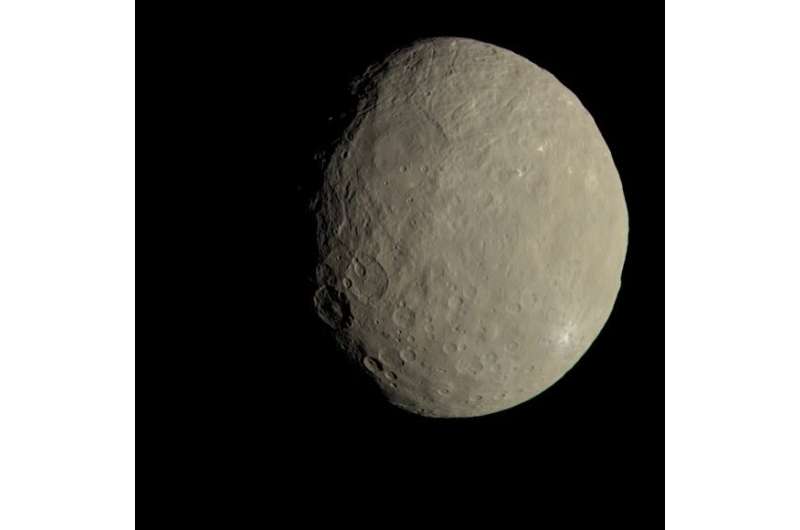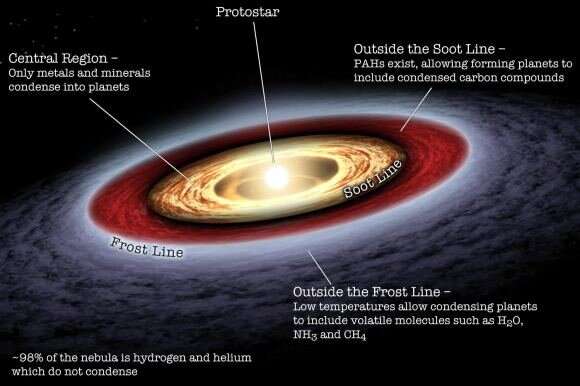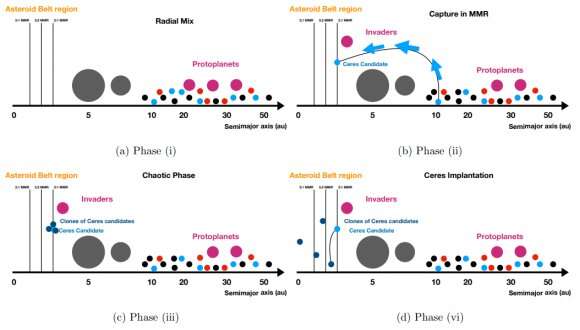Ceres probably formed farther out in the solar system and migrated inward

When Sicilian astronomer Giuseppe Piazzi spotted Ceres in 1801, he thought it was a planet. Astronomers didn't know about asteroids at that time. Now we know there's an enormous quantity of them, primarily residing in the main asteroid belt between Mars and Jupiter.
Ceres is about 1,000 km in diameter and accounts for a third of the mass in the main asteroid belt. It dwarfs most of the other bodies in the belt. Now we know that it's a planet—albeit a dwarf one—even though its neighbors are mostly asteroids.
But what's a dwarf planet doing in the asteroid belt?
A new research article provides the answer: Ceres didn't form in the asteroid belt. It formed further out in the solar system and then migrated to its current position. This isn't the first study to reach that conclusion, but it adds weight to the idea.
The article is "Dynamical Origin of the Dwarf Planet Ceres," and it's published in the journal Icarus. The lead author is Rafael Ribeiro de Sousa, a physics professor at Sao Paulo State University in Brazil. Other co-authors come from the same university and France and the U.S.
(Note: Ceres is called a dwarf planet, a protoplanet, and sometimes an asteroid. No point getting hung up on it. It was officially classified as a dwarf planet in 2006.)
Ceres is one of three dwarf planets or protoplanets in the asteroid belt. The other two are Vesta and Pallas. A fourth large body, Hygiea, is 434 km in diameter and may also be a dwarf planet. These four largest bodies make up half the mass of the asteroid belt.
Most of what we know about Ceres comes from NASA's Dawn mission. Dawn was the first spacecraft to visit two extraterrestrial bodies and the first to orbit a dwarf planet. Dawn visited both Vesta and Ceres before the spacecraft ran out of fuel in October 2018. Now it's a derelict in a stable orbit around Ceres.
The terminology and descriptions of the largest objects in the asteroid belt can be confusing, but Ceres stands apart from the other three. Ceres is the only body in the belt that's massive enough to maintain a spheroid shape. Ceres also has a transient atmosphere called an exosphere. Sunlight sublimes water ice and ammonia ice into vapor, but the dwarf planet's gravity is too weak to hold onto it. This is an important clue to Ceres' origins because asteroids don't typically emit vapor.

The presence of ammonia is also a clue.
Comets contain volatile ices like ammonia that sublime when the sun heats them. That's what creates the comet's tail and coma. But comets come from the cold outer regions of the solar system where they would've accreted the volatile ices. Since Ceres has frozen volatiles like a comet, it suggests that it also originated in the colder regions of the solar system.
"The presence of ammonia ice is strong observational evidence that Ceres may have been formed in the coldest region of the solar system beyond the Frost Line, in temperatures low enough to cause condensation and fusion of water and such volatile substances as carbon monoxide [CO], carbon dioxide [CO2] and ammonia [NH3]," Ribeiro de Sousa said in a press release.
The boundary between the colder outer solar system and the warmer inner solar system is called the Frost Line. There are specific frost lines for different volatiles which freeze at different temperatures, but astrophysicists speak of a single frost line for simplicity. The frost line is close to Jupiter's orbit now, but it hasn't always been there. It's moved as the solar system evolved. The solar nebula was opaque in the early days, and the sun's warmth didn't reach as far. The sun was also less energetic then, so the frost line was closer to the sun.

The growth of the giant planets also affected the position of the frost line. "The intense gravitational disturbance produced by the growth of these planets may have changed the density, pressure and temperature of the protoplanetary disk, displacing the Frost Line. This disturbance in the protoplanetary gas disk may have led the expanding planets to migrate to orbits closer to the sun as they acquired gas and solids," co-author Ernesto Vieira Neto said.
"In our article, we propose a scenario to explain why Ceres is so different from neighboring asteroids. In this scenario, Ceres began forming in an orbit well beyond Saturn, where ammonia was abundant. During the giant planet growth stage, it was pulled into the asteroid belt as a migrant from the outer solar system and survived for 4.5 billion years until now," Ribeiro de Sousa said.
The team ran a large number of computer simulations to test the idea. They simulated the formation of giant planets inside the sun's protoplanetary disk, including Jupiter and Saturn. They also included some embryonic planets to serve as precursors to Uranus and Neptune. Then they added a group of objects with compositions and sizes similar to Ceres. Their inclusion is based on the assumption that Ceres is one of the solar system's early planetesimals, objects on their way to becoming full-fledged planets.
"Our simulations showed that the giant planet formation stage was highly turbulent, with huge collisions between the precursors of Uranus and Neptune, ejection of planets out of the solar system, and even invasion of the inner region by planets with masses greater than three times Earth's mass. In addition, the strong gravitational disturbance scattered objects similar to Ceres everywhere. Some may well have reached the region of the asteroid belt and acquired stable orbits capable of surviving other events," Ribeiro de Sousa said.

The researchers say there are four steps involved in a Ceres-like object becoming implanted in the asteroid belt. The first is a fast radial mixing phase in the position of the planetesimals in the outer planetesimal disk. The second is when the Ceres candidate gets captured in mean-motion resonance with giant planets. The third step is a chaotic phase, where the Ceres-like object can encounter other "invaders" that can increase or decrease its eccentricity and scatter the object into more stable regions in the inner asteroid belt. The chaotic phase also includes gas drag and gaseous dynamical friction that can change the Ceres candidate's eccentricity and inclination and implant it into its current position. The fourth phase is where the gas is removed from the protoplanetary disk, invaders are removed, Ceres is removed from mean-motion resonance, and the implantation becomes stable.
The team's simulations also showed that Ceres is only one of many objects like it that existed in the solar system's early days. "Our main finding was that in the past, there were at least 3,600 Ceres-like objects beyond Saturn's orbit. With this number of objects, our model showed that one of them could have been transported and captured in the asteroid belt, in an orbit very similar to Ceres's current orbit," Ribeiro de Sousa said.
These aren't the first researchers to come up with a number like 3,600 Ceres-like objects. Others have studied craters and the number of objects beyond Saturn and in the Kuiper Belt to come up with their results. This study confirms previous results and supports our understanding of how the solar system formed and evolved. "Our scenario enabled us to confirm the number and explain Ceres' orbital and chemical properties. The study reaffirms the accuracy of the most recent models of the formation of the solar system," he said.
More information: Rafael Ribeiro de Sousa et al, Dynamical origin of the Dwarf Planet Ceres, Icarus (2022). DOI: 10.1016/j.icarus.2022.114933
Journal information: Icarus
Provided by Universe Today


















